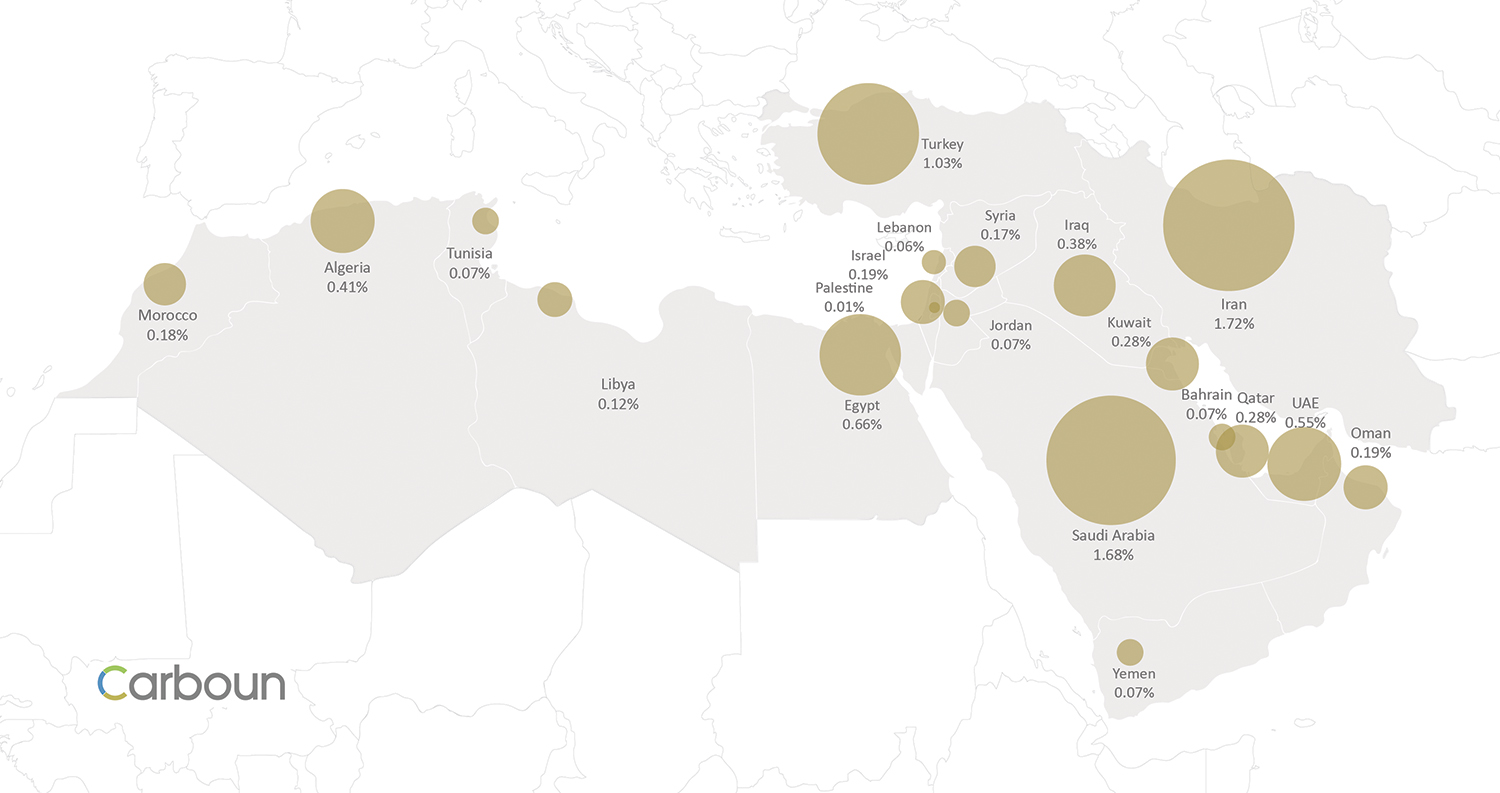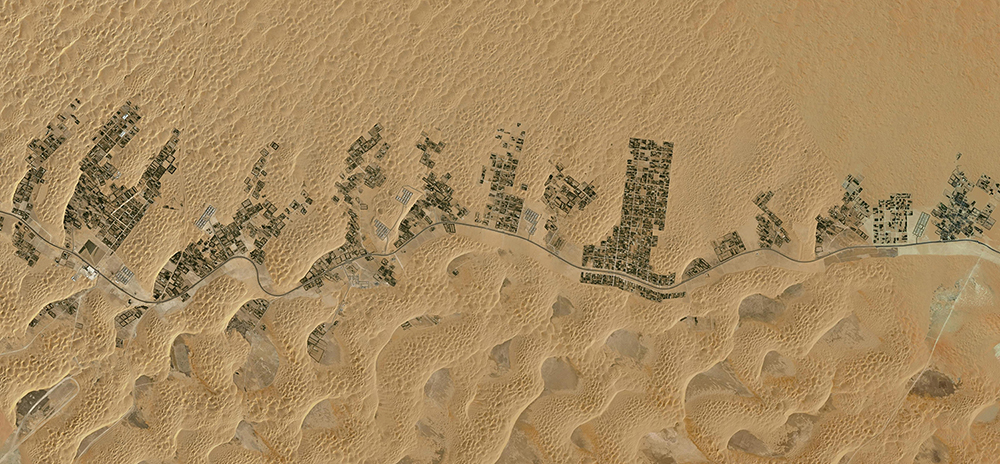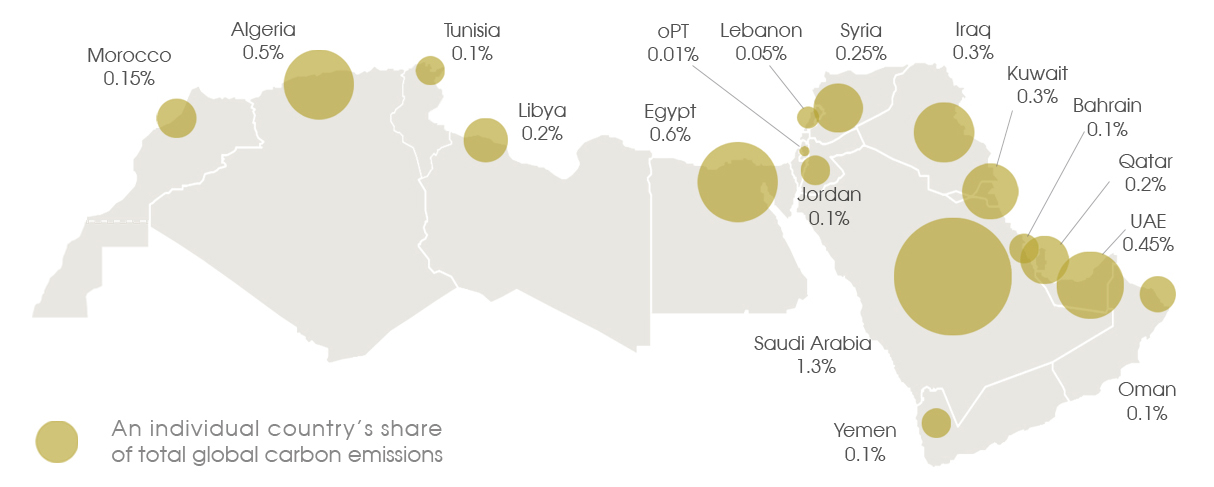|
|
 National share of 2014 global carbon emissions across the Middle East and North Africa region, including Turkey, Iran, and Israel. Copyrights: Carboun Karim Elgendy
The two-week COP 21 climate conference in paris (also known as the 21st Conference of Parties to the United National Framework Convention for Climate Change ) ended on Saturday 12 December with an adopted agreement covering 195 countries, and providing a framework for voluntary efforts to significantly reduce carbon emissions starting 2020.
Continue reading From Paris to Marrakech and Beyond
Karim Elgendy
 Liwa date farms benefit from some of the freshest ground water in the UAE. Copyrights: Google Those who visit the Middle East and North Africa from more temperate climates are often struck with how hot and dry the region is, and how scarce its rainfall. Some wonder why cities became established here, and how they continue to exist despite the lack of renewable freshwater.
These concerns are not entirely groundless. Yet these cities’ existence is not in any way miraculous: it’s merely an example of what can happen if cities fail to strike a sustainable balance between growth and limited resources.
Continue reading How Sustainable is Your Oasis?: A Review of Water Resources in Middle East Cities

Karim Elgendy
In celebrating this year’s World Green Building Week, Carboun has released a visual guide to energy use in buildings with the goal of explaining the overall state of energy use in the region and the significance of buildings as a major sector in energy consumption. It also aims to comparatively explain the nuances of the major trends of energy use in buildings as a baseline analysis for further research. The visual guide, which was researched and designed by Karim Elgendy with additional contributions from a small research team, was based on raw data obtained from the International Energy Agency and the World Bank. Copyrights for all infographics are reserved for Carboun. No reproduction or republishing of any infographic or part thereof is permitted without prior written consent from the author.
Continue reading A Visual Guide to Energy Use in Buildings in the Middle East

Karim Elgendy
Following on Carboun’s recent article discussing the two trends of energy and carbon emissions in the Arab World. Carboun has recently released a visual guide to energy and emissions with the goal of explaining the fundamentals of energy use in the region and how it relates to carbon emissions, economic development, climate change, and renewable energy. The guide, which was researched and designed by Karim Elgendy, was based on raw data provided by the World Bank and the World Resources Institute. It aims to explain the regional trends in local details but within the global context. Copyrights for all infographics are reserved for Carboun. No reproduction or republishing of any infographic or part thereof without prior written consent from Carboun.
Continue reading A Visual Guide to Energy and Emissions in the Middle East
Karim Elgendy
Discussions on the environment in the Arab World have traditionally been limited to the negative impact of region’s fossil fuel exports on climate change. In recents years, a more regional discourse has emerged that also addressed the region’s water scarcity, rapid urbanization, environmental degradation, and the expected impact of global climate change and sea level rise on its most vulnerable regions.
 Map showing emissions in countries of the arab world as percentage of global emissions. Copyrights: Carboun However, such discussions often overlooked the region’s own energy and ecological footprints and the impact of its own energy use on climate change. In the past , such disregard may have been justified by the fact that the region had not yet experienced the kind of economic development and prevalent consumerism that was common in most of the developed world. Such justification was supported by the region’s historically low rate of energy use and carbon emissions. In fact, the Arab world which constitutes 5% of the world’s population, emits just under 5% of global carbon emissions according to World Bank data, and except for Saudi Arabia, no single Arab country is responsible for more than 1% of global emissions. The energy use of an average Arab person is still below the world average and less than half that of an average european.
Continue reading Two Trends of Energy and Carbon Emissions in the Arab World
Karim Elgendy
A pan-Arab survey conducted by the Arab Forum for Environment and Development (AFED) found that a resounding majority of 98% believed that the climate is changing.
The survey sample which included a big segment of educated people (who more reflect the views of those nearer to decision making, than proportionally reflect the actual population mix) showed that only a small portion of 5% said they did not understand what climate change was, reaching a maximum of 11% in Syria. However, 95% of those who said they did not understand what climate change was, still answered that they believed the weather was changing, (Figure 1). A majority of 89% also thought that this change was due to human activities, including excessive use of energy and depletion of resources, (Figure 2). These results clearly showed that climate change has become widely accepted by the public in Arab countries as a fact which needs to be addressed. Moreover, the survey showed that the skeptical attitudes which prevailed among some groups on the facts and causes of climate change, either denying it entirely or limiting it to natural causes, are decreasing.
 Survey Figure 1. Source: AFED Arab Environment Climate Change Report. Continue reading The Arab World’s Opinion on Climate Change
Karim Elgendy
In recent years much of the discussion about the impact of climate change around the world has caused a mix of anxiety and fear about the impacts this may have on human life and the environment. Many detailed studies have shown by using simulation models the impact of sea level rises on coastal cities around the world if sea level were to rise by a certain degree. These studies showed that generally speaking, it was low lying areas and river deltas that were most vulnerable, especially when these deltas are densely populated.
 Figure 1. Relative vulnerability of coastal deltas as shown by the indicative population potentially displaced by current sea-level trends to 2050 (Extreme = > 1 million; High = 1 million to 50,000; Medium = 50,000 to 5,000 (following Ericson et al.,2006). Source Nicholls, R.J., P.P. Wong, V.R. Burkett, J.O. Codignotto, J.E. Hay, R.F. McLean, S. Ragoonaden and C.D. Woodroffe, 2007 Continue reading The Impact of Sea Level Rise on The Arab World
|
|







